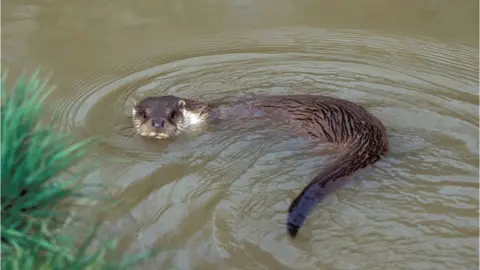Otters 'breeding for first time' in Peak District
Evidence of otters breeding in the Peak District has been found for the first time, scientists at the University of Sheffield have said.
Footage of an otter and its cub on a river bank in the national park, which mostly covers Derbyshire, was captured as part of a research project.
Dr Deborah Dawson said she was "delighted" as recovery for the animals in northern England had been slow.
Otter numbers have improved in the UK following a sharp drop in the 1970s.
Dr Dawson, from the University of Sheffield, who led the study, said the footage shows the animals sniffing for spraints (droppings) left by other otters - which locates their presence.
"We are absolutely delighted to have captured the first evidence of wild otters breeding in the Peak District," she said.
"Otter numbers crashed in the UK becoming locally extinct in much of England by the 1970s.
"Bans on pesticides, legal protection, improvements in water quality and targeted conservation efforts have led to the return of the otter to many counties."
She added that despite the good news more needed to be done to improve river bank habitats across the country.
The University of Sheffield scientists said they conducted the first ever DNA-based survey of otter numbers in the north of England and detected seven of the species on the River Don in 2017, including at least two males.
Otters were detected in locations across the South Yorkshire region, with a female being detected in a rural area north of Sheffield.

British otters
 AFP
AFP- Otters are one of the UK's top predators and mainly feed on fish, amphibians and crustaceans
- They require clean rivers, with an abundant source of food
- They are protected in the UK under the Wildlife and Countryside Act, 1981
- The mammals are elusive so footprints and their droppings are indicators of their presence
- Otters leave spraints/droppings in prominent places, such as fallen trees, weirs and bridges, as "scented messages"
Source:Wildlife Trusts

Follow BBC East Midlands on Facebook, on Twitter, or on Instagram. Send your story ideas to [email protected].
